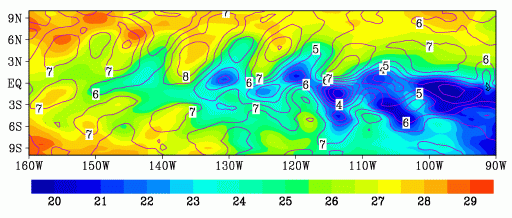
Tropical Instability Wave
W. Timothy Liu, NASA Jet Propulsion Laboratory
Sea surface temperature (SST) observed by the Microwave Imager on the
Tropical Rain Measuring Mission (TRMM), shown as color image, and surface
wind speed (SWS), shown as isotachs, measured by the SeaWinds scatterometer
on QuikSCAT, on 11 September 1999, clearly reveal the atmospheric
manifestation of tropical instability waves (TIW) in the tropical Pacific.
 The TIW were best observed by radiometers on geostationary satellites as
meanders of the temperature front between the cold upwelling water of the
Pacific equatorial cold tongue and the warm water to the north. The waves
propagate westward, with period of approximately 30 days. The waves are
stronger from June to November and during the anomalous cold events of La
Nina. SST is often obscured from visible and infrared radiometers by cloud
cover. Because the atmosphere and the clouds are transparent to microwave,
the coincident measurements at microwave frequencies by TRMM and QuikSCAT
during the La Nina episode in the second half of 1999 provided
unprecedented opportunity to observe the influence of SST front on the
atmosphere. A unique zonal-temporal band-pass filter enables the isolation
of the propagating signals and the determination of their phase
differences. The phase differences between the propagation of wind vector
and SST observed from space and the vertical wind profiles measured from a
research ship are consistent with the hypothesis the coupling between SWS
and SST is caused by buoyancy instability and mixing which reduces the wind
shear in the atmospheric boundary layer. Details of the result can be
found in
Liu et al. [Geophys. Res. Lett, 27, No 16, 2545-2548].
The TIW were best observed by radiometers on geostationary satellites as
meanders of the temperature front between the cold upwelling water of the
Pacific equatorial cold tongue and the warm water to the north. The waves
propagate westward, with period of approximately 30 days. The waves are
stronger from June to November and during the anomalous cold events of La
Nina. SST is often obscured from visible and infrared radiometers by cloud
cover. Because the atmosphere and the clouds are transparent to microwave,
the coincident measurements at microwave frequencies by TRMM and QuikSCAT
during the La Nina episode in the second half of 1999 provided
unprecedented opportunity to observe the influence of SST front on the
atmosphere. A unique zonal-temporal band-pass filter enables the isolation
of the propagating signals and the determination of their phase
differences. The phase differences between the propagation of wind vector
and SST observed from space and the vertical wind profiles measured from a
research ship are consistent with the hypothesis the coupling between SWS
and SST is caused by buoyancy instability and mixing which reduces the wind
shear in the atmospheric boundary layer. Details of the result can be
found in
Liu et al. [Geophys. Res. Lett, 27, No 16, 2545-2548].

 The TIW were best observed by radiometers on geostationary satellites as
meanders of the temperature front between the cold upwelling water of the
Pacific equatorial cold tongue and the warm water to the north. The waves
propagate westward, with period of approximately 30 days. The waves are
stronger from June to November and during the anomalous cold events of La
Nina. SST is often obscured from visible and infrared radiometers by cloud
cover. Because the atmosphere and the clouds are transparent to microwave,
the coincident measurements at microwave frequencies by TRMM and QuikSCAT
during the La Nina episode in the second half of 1999 provided
unprecedented opportunity to observe the influence of SST front on the
atmosphere. A unique zonal-temporal band-pass filter enables the isolation
of the propagating signals and the determination of their phase
differences. The phase differences between the propagation of wind vector
and SST observed from space and the vertical wind profiles measured from a
research ship are consistent with the hypothesis the coupling between SWS
and SST is caused by buoyancy instability and mixing which reduces the wind
shear in the atmospheric boundary layer. Details of the result can be
found in
Liu et al. [Geophys. Res. Lett, 27, No 16, 2545-2548].
The TIW were best observed by radiometers on geostationary satellites as
meanders of the temperature front between the cold upwelling water of the
Pacific equatorial cold tongue and the warm water to the north. The waves
propagate westward, with period of approximately 30 days. The waves are
stronger from June to November and during the anomalous cold events of La
Nina. SST is often obscured from visible and infrared radiometers by cloud
cover. Because the atmosphere and the clouds are transparent to microwave,
the coincident measurements at microwave frequencies by TRMM and QuikSCAT
during the La Nina episode in the second half of 1999 provided
unprecedented opportunity to observe the influence of SST front on the
atmosphere. A unique zonal-temporal band-pass filter enables the isolation
of the propagating signals and the determination of their phase
differences. The phase differences between the propagation of wind vector
and SST observed from space and the vertical wind profiles measured from a
research ship are consistent with the hypothesis the coupling between SWS
and SST is caused by buoyancy instability and mixing which reduces the wind
shear in the atmospheric boundary layer. Details of the result can be
found in
Liu et al. [Geophys. Res. Lett, 27, No 16, 2545-2548].